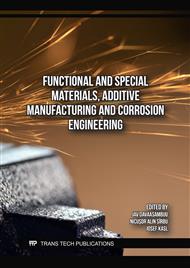[1]
J. Wang, M. J. Han, Y. N. Liu. Multifunctional microwave absorption materials of multiscale cobalt sulfide/diatoms co-doped carbon aerogel, J. Journal of Colloid and Interface Science. 646 (2023) 970-979.
DOI: 10.1016/j.jcis.2023.05.094
Google Scholar
[2]
M. N. Zhan, F. Liu, C. Li, et al. Research progress on carbon aerogels and their composites for environmental applications, J. Progress of Materials in China. 42 (2023) 64-73.
Google Scholar
[3]
C. Vakifahmetoglu, T. Semerci, A. Gurlo, et al. Polymer derived ceramic aerogels, J. Current Opinion in Solid State and Materials Science. 25 (2021) 100936.
DOI: 10.1016/j.cossms.2021.100936
Google Scholar
[4]
N. Rai, I. Chauhan, Multifunctional. Aerogels: A comprehensive review on types, synthesis and applications of aerogels, J. Journal of Sol-Gel Science and Technology. 105 (2023) 324-336.
DOI: 10.1007/s10971-022-06026-1
Google Scholar
[5]
C. M. R. Almeida, M. E. Ghica, L. Duraes. An overview on alumina-silica-based aerogels, J. Advances in Colloid and Interface Science. 282 (2020)102189.
DOI: 10.1016/j.cis.2020.102189
Google Scholar
[6]
H. He, Q. Liu, S. D. Zhang, et al. Fabrication and properties of polyimide/carbon fiber aerogel and the derivative carbon aerogel, J. Industrial & Engineering Chemistry Research. 61 (2022) 3952-3961.
DOI: 10.1021/acs.iecr.1c04654
Google Scholar
[7]
W. Liao, K. Xiao, T. Tian, et al. Carbon aerogel monoliths from polymers: A review, J. Journal of Cleaner Production. (2024):140736.
DOI: 10.1016/j.jclepro.2024.140736
Google Scholar
[8]
M. Li, B. Pang, S. Dai, et al. Sustainable biomass-derived carbon aerogels for energy storage applications, J. Chemical Engineering Journal.499 (2024): 156693.
DOI: 10.1016/j.cej.2024.156693
Google Scholar
[9]
J. H. Lee, S. J. Park. Recent advances in preparations and applications of carbon aerogels: A review, J. Carbon. 163 (2020) 1-18.
DOI: 10.1016/j.carbon.2020.02.073
Google Scholar
[10]
P. Jõul, O. Järvik, H. Lees, et al. Preparation and characterization of lignin-derived carbon aerogels, J. Frontiers in Chemistry. 11 (2024) 1326454.
DOI: 10.3389/fchem.2023.1326454
Google Scholar
[11]
G. Gan, X. Li, S. Fan, et al. Carbon aerogels for environmental clean‐up, J. European journal of inorganic chemistry. 27 (2019) 3126-3141.
DOI: 10.1002/ejic.201801512
Google Scholar
[12]
A. Bhatnagar, A. P. Pandey, M. S. L. Hudson, et al. Economical synthesis of highly efficient and tunable carbon aerogels for enhanced storage of CO2 emitted from energy sources, J. International Journal of Energy Research. 45 (2021) 6285-6292.
DOI: 10.1002/er.6251
Google Scholar
[13]
V. A.Edlabadkar, R. U. Soni, A. B. M. S. Doulah, et al. CO2 uptake by microporous carbon aerogels derived from polybenzoxazine and analogous all-nitrogen polybenzodiazine aerogels, J. Chemistry of Materials. 36 (2024) 1172-1187.
DOI: 10.1021/acs.chemmater.3c01717.s001
Google Scholar
[14]
M. Peydayesh, J. Vogt, X. Chen, et al. Amyloid-based carbon aerogels for water purification, J. Chemical Engineering Journal. 449 (2022) 137703.
DOI: 10.1016/j.cej.2022.137703
Google Scholar
[15]
Y. Cui, W. Kang, J. Hu. Construction of a carbon nanosphere aerogel with magnetic response for efficient oil/water separation, J. New Journal of Chemistry. 46 (2022) 20985-20994.
DOI: 10.1039/d2nj04450a
Google Scholar
[16]
M. Aghabararpour, M. Naderi, S. Motahari, et al. A study on resorcinol formaldehyde carbon aerogel/epoxy nanocomposites: the effect of carbon aerogel pyrolysis time, J. Journal of Polymer Research. 26 (2019) 1-8.
DOI: 10.1007/s10965-019-1721-9
Google Scholar
[17]
F. Chen, M. Xu, L. Wang, et al. Preparation and characterization of organic aerogels from a lignin-resorcinol-formaldehyde copolymer, J. BioResources. 6 (2021) 1262-1272.
DOI: 10.15376/biores.6.2.1262-1272
Google Scholar
[18]
G. B. Veselov, A. A. Vedyagin. Resorcinol-formaldehyde-derived carbon xerogels: preparation, Functionalization and Application Aspects, J. Materials. 16 (2023) 6566.
DOI: 10.3390/ma16196566
Google Scholar
[19]
X. Wang, Y. Zhang, H. Jiang, et al. Fabrication and characterization of nano-cellulose aerogels via supercritical CO2 drying technology, J. Materials Letters. 183 (2016) 179-182.
DOI: 10.1016/j.matlet.2016.07.081
Google Scholar
[20]
N. Menshutina, P. Tsygankov, I. Khudeev, et al. Intensification methods of supercritical drying for aerogels production, J. Drying Technology. 40 (2022) 1278-1291.
DOI: 10.1080/07373937.2020.1866005
Google Scholar
[21]
S. Yu, T. Budtova. Creating and exploring carboxymethyl cellulose aerogels as drug delivery devices, J. Carbohydrate Polymers. 332 (2024) 121925.
DOI: 10.1016/j.carbpol.2024.121925
Google Scholar


